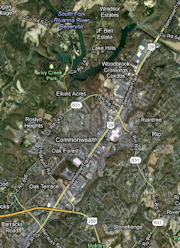by James A. Bacon
I’m back from Vegas (nothing happened there that had to stay there, by the way), and I’m catching up on what I missed while I was gone. It seems that the Charlottesville Bypass had one of its periodic flare-ups, as many citizens got it into their heads that they should be able to comment upon the final Bypass design before the estimated $245 million project enters the construction phase.
It’s hard to blame them. The last official public hearing took place in 1997, and much has changed since then. All manner of design schematics have been made public but no one yet knows what the final version will look like. The route is pretty well nailed down, but no one knows how the northern and southern termini will be configured, how steep the incline over Stillhouse Mountain will be, or what other trade-offs the winning bidder might make in order to keep the project within the $197 million appropriated to complete the project.
Uncertainty is inherent in the nature of the fast-tracked process which the McDonnell administration has employed to move the controversial project ahead. In theory, the design-build process will do a better job of constraining costs than the traditional design-bid-build process in which the Virginia Department of Transportation (VDOT) designs the project, obtains public input and only then puts the job out for bids. Under design-bid-build, cost overruns are common because the contractor bears little risk: The builder simply bills VDOT for change orders and unanticipated expenses.
Design-build is said to be more efficient because road-building contractors can do much of the design and construction work simultaneously, dramatically cutting the length of time it takes to complete a project. Also, while VDOT sets the broad design parameters and provides a preliminary design to work from, the contractor is given considerable leeway to approach the task creatively and come up with more cost-effective design solutions.
In the case of the Charlottesville Bypass, however, the proposed solutions will kept under wraps until VDOT has evaluated the bids and selected a winner. At Once the design plan has been set, it will be difficult to implement any substantive changes that arise from public feedback. Thus, while design-build may save money, it won’t necessarily lead to the best result if the contractor makes design decisions that prove unpopular.
The issue is coming to a head in Albemarle County now that VDOT has begun evaluating the seven bids it has received for the project. There is no telling what the proposals might contain, given the many uncertainties created in VDOT’s bid offering. Randy Salzman, a Charlottesville-area writer who has delved deeply into the VDOT bid documents, provides this assessment:
VDOT’s own documents… [confuse] any potential “design-build” bidder on the Western Bypass and most likely [cause] him/her to either not bid or drive the price beyond imagining.
For example, the most common phrase in January’s “Route 29: C-ville’s Bypass Project Request for Proposal Question and Answers” was [a statement that] the bidder’s question would be addressed “in a forthcoming addendum” — which never materialized prior to bid closure. When the info was available, usually from a 1997 update, VDOT consistently added this sentence: “The Department does not represent or warrant that the information contained in the Supplemental Information Package is reliable or accurate or suitable for designing this project.”
Given the uncertainties, bids could be all over the map, with different contractors basing their bids on different assumptions and leading to very different design solutions.
Earlier this week, Dennis Rooker and his allies on the Albemarle County Board of Supervisors tried to pass a resolution requesting VDOT to hold a formal public hearing rather than a simple informational meeting, as currently planned. As reported by Charlottesville Tomorrow:
Rooker argued in favor of a public hearing in part because VDOT does not intend to make the project’s design public until a contract has been awarded. Normal procedure for design-build projects, he said, includes opportunities for public hearings on design.
“In this case, the public won’t have the opportunity to see the design until the contract has been awarded,” he said. “Think about that.”
The board deadlocked, 3-3, on Rooker’s proposal, effectively defeating it.
At this point, it’s anybody’s guess what the bids will look like, what they will cost, what trade-offs the bidders will propose and how the final design will be viewed by the inhabitants of Charlottesville and Albemarle County.



